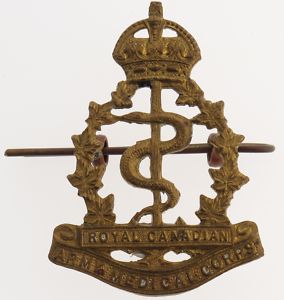Prior to the outbreak of war, the Canadian military possessed few of the resources required to respond to wounded soldiers' needs. The body responsible for such matters - the Militia Medical Service - was first formed in 1899. Its weaknesses quickly became apparent during the Boer (South African) War (1899-1902), prompting a reorganization of the military medical system after its conclusion.
 |
| CAMC Cap Badge |
 |
| CAMC Nursing Sisters. |
The recently created field ambulance represented the first level of medical care, providing immediate treatment and determining the subsequent course of action. A soldier suffering from a minor wound or illness - for instance, a case of influenza - might return to his unit after a brief stay. If the soldier required further care, he was transported to a casualty clearing station which facilitated the transfer of the wounded to a permanent hospital. The first Canadian clearing station was established at Fort Gassion, near Aire, France in March 1915. By war's end, four Canadian clearing stations were operating near the front lines.
 |
| Artist's sketch of field ambulance in action at the front. |
While stationary hospitals initially contained 200 beds, the high number of casualties forced the CAMC to double their capacity by the end of 1915. In some instances, numbers rose as high as 650 beds. One unit - Stationary Hospital No. 3 - consisted of 1090 beds at one point in 1918. Canadian stationary hospitals operated in England, France, Greece, Egypt and Siberia at various times during the war. A total of eleven Canadian stationary hospitals were created during the conflict, although several were later transformed into the next level of medical care.
 |
| No. 7 Canadian Stationary Hospital (staffed by Dalhousie University personnel). |
The first Canadian general hospital established in France - No. 2 - set up operations at Le Treport, a small port on the English Channel, in March 1915. A second unit - General Hospital No. 1 - began operations at Etaples in May 1915. By war's end, a total of 16 Canadian general hospitals were operating in France, England and Greece.
 |
| Interior of No. 7 Canadian General Hospital, France. |
The two largest Canadian convalescent facilities were Woodcote Park, Epsom (3900 beds) and Princess Patricia's Red Cross Convalescent Hospital, founded at Ramsgate and later relocated to Bexhill (2250 beds). Patients returned to combat if deemed "fit for duty" upon recovery. Soldiers whose wounds made return to combat impossible were transported to Canada, where they were discharged from military service.
 |
| Canadian Convalescent Hospital, Bear Wood, England. |
Given its limited size and experience at the beginning of the war, the performance of the Canadian Army Medical Corps was truly remarkable. Altogether, 89 % of patients reaching a Canadian hospital survived their injuries. The response of qualified Canadians to the pressing need for medical personnel is also noteworthy. More than half of all Canadian physicians served overseas at some time during the war.
 |
| CAMC nursing sisters caring for wounded soldiers. |
*****
The following web links provide additional information on the Canadian Army Medical Corps and the network of facilities created to provide medical care for soldiers wounded during the war:
The Canadian Great War Project web site contains two tables outlining the growth of CAMC medical services in England and France during the war.
The Anzac Day.org website contains a diagram outlining the "casualty evacuation system" developed in France and England in response to battlefield casualties.
*****
Sources:
Adami, J. George. War Story of the Canadian Army Corps. Canadian War Records Office. Available online.
Canada and the First World War - Canadian Army Medical Corps. Canadian War Museum. Available online.
Canadian Army Medical Corps. Canadian Great War Project. Available online.
Royal Canadian Army Medical Corps. Wikipedia - The Free Encyclopedia. Available online.
Your Information is so informative.
ReplyDeleteFood Recruitment
Thank you for the positive feedback, V. K.! I'm glad that you find the content of value. :)
ReplyDeleteThe McMaster University website identifies and dates the CAMC Nursing Sisters' group photo May 1942
ReplyDeleteThanks, Wayne. I will check the website for the photo information.
Delete